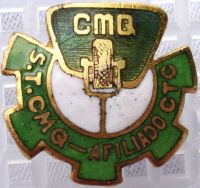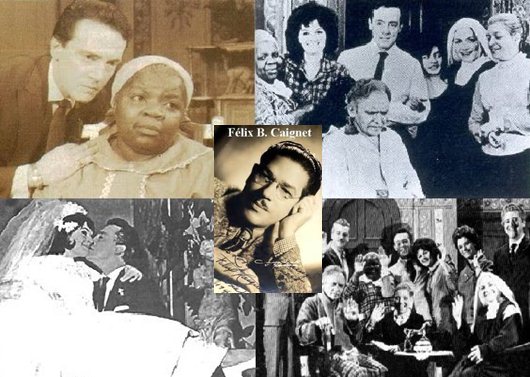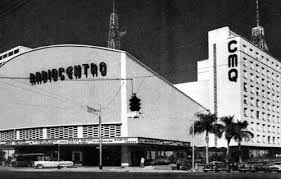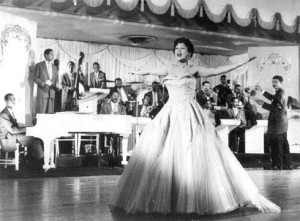The Supreme Court of Art was the name given to a famous radio program in Cuba in the late thirties and forties. It came to be considered the most famous contest on Spanish-language radio at the time and it was the quarry where many star artists emerged.
The program first appeared on the air on December 1, 1937, at the studios of the CMQ station, at that time owned by the businessmen Ángel Cambó and Miguel Gabriel. The main reason for the creation of this radio space was the need to discover new voices through the creation of a program of fans to the form of others already popular in the United States. At first, the program occupied only one space per week, but when it reached popularity, it moved to a daily frequency in a space of two hours. On Saturdays, the selected ones competed.
Everything arose when Miguel Gabriel and Angel Cambó, then owners of the CMQ, wanted to give more structure to their music and variety programs, they found a difficulty: the few lyric figures they had charged too high fees for the time and the real possibilities of the station.
It was then that they devised the formula to give spectacular entry to the fans that could become stars of the radio. From there arose the phrase that is still used of “They touched the bell” to indicate that someone is unable to reach their goal because another prevents it. Because the Supreme Court of Art certainly touched the bell to that interpreter, singer or reciter, who was notoriously bad.
CMQ RADIO.
That bell, which from the control booth and out of sight of the public and the same performer, played Miguel Gabriel, gave the program its initial appeal, which began to air on the 1st. of December of 1937, from the studies that that station had in Monte almost corner to Cárdenas, in Havana, and to those that allude, of invariable way and by comfort, like located in Monte and Prado.
Soon the prizes and gifts that the winners won attracted a huge number of applicants. Running the years, already in the fifties, José Antonio Alonso, known until then as a declaimer and commentator, consolidated it with his original conduction in his own program “The Show of Jose Antonio Alonso”.
Alonso, his driver, had his own style and culture, he knew how to improvise and his comments were always accurate. He famously made a phrase that marked the beginning of the test. “Who is going to dedicate it?” He asked the applicant. He answered this and immediately Alonso, addressing the conductor of the orchestra, added: “Music, maestro!”, A formula that is still used in many shows in the world.
Thus arose a whole plethora of young values launched by CMQ. With their patronage, they were at parties and ceremonies, not just in the capital; also in cities of the interior of the Island, and many of them did not delay in consolidating and capitalizing on the sympathies of the public.
At the beginning, the candidates were submitted to a previous selection by means of essays but later, the overcrowding determined that amateurs would be presented if they had previously evaluated. In this circumstance the element of the “Bell” was included, which was nothing more than a timbre that was blown to interrupt the performance when the aspiring artist did not measure up.
The popularity of the space determined that for its realization it will be transferred from the studios of the station to the stage of the National Theater of Havana. Contests were also held in other cities on the island. Those that were winners of the contest were hired by the CMQ radio station as professional artists in the radio presentations of said station.
The extensive relationship of Cuban artists emerged in that artistic melting pot that was “The Supreme Court of Art” in the Cuban Twentieth Century, is infinite, and later with the continuity of Jose Antonio Alonso, allowed with this symbolism to all in two beloved women that emerged from its initial stage in the 30s.
Xiomara Fernández, now deceased, excellent declaimer, actress and singer and, in addition, an announcer who broke mediatic prejudices by becoming the first Cuban woman to alternate with two men the radio speech in “De Fiesta con Bacardi” CMQ Radio’s star program (Monday to Saturday, 9:30 a.m. to 10: 00 p.m.) to which all the foreign guests of the plant attended and which earned him the nickname of “the voice of the national locution.” And Rosita Fornés, the vedette of Cuba who still continues every day, her extraordinary artistic career in music, speech and acting, touring throughout the country and actively participating in our cultural life.
With the passing of time, when we investigate and try to reconstruct Cuban media history, we forget that the expansion and flow of our artists, genres and products throughout the Americas was made possible, among other factors, by the shortwave radio broadcast, a support of outsize promotion that allowed first in the case of CMQ Radio, the dissemination of the “Supreme Court of Art”, beyond the Cuban archipelago and even in Europe and Asia and that would later favor the circulation of Cuban radio soap operas as ” The Right to Be Born “and adventures such as” The Three Villalobos “and” Tamakun the Avenger “, just to cite the top examples.
The CSA gave a great boost to the Zarzuela in Cuba, by providing the groups of this genre with new talents. It was also the quarry from which numerous singers emerged who later enjoyed great popularity as Carlos Embale, Elena Burke, Olga Guillot, Tito Gómez, Celia Cruz, Rosita Fornés, Raquel Revuelta, Elena Burke, Ramón Veloz, Obdulia Breijo, the duo Hermanas Martí , Natalia Herrera, Armando Bianchi … among others.
It was also an expression of the fierce commercial competition that in those years began to be felt on the radio. The Supreme Court of Art was sponsored at the beginning by Competitor Gaditana, “the unbeatable cigar”, as its slogan read. When the program obtained a sensational success, Miguel Gabriel, in one of his moves of audacity, raised in an unusual way the figure that the advertiser had to pay, and forced Competitor to leave the field to a rival company, that of cigars Regalías el Cuño, which previously had committed to pay 12,000 pesos per month for space. Enormous figure in those moments, and that marked the first step towards high investment budgets in the radio.
Apart from all the positive and negative ups and downs, ‘The Supreme Court of Art’ revealed and impelled many enduring values of the art of the beautiful history of our beautiful and pained Cuban republic today.
“LA CORTE SUPREMA DEL ARTE”, EL PROGRAMA DE CONCURSO MAS POPULAR EN LA RADIO CUBANA DE AYER.
La Corte Suprema del Arte fue el nombre dado a un célebre programa de radio en la Cuba de fines de los años treinta y cuarenta. Llegó a ser considerado el concurso más famoso en la radio de habla hispana de la época y fue la cantera donde surgieron muchos artistas estelares.
El programa salió por primera vez al aire el 1 de diciembre de 1937, en los estudios de la emisora CMQ, a la sazón propiedad de los empresarios Ángel Cambó y Miguel Gabriel. La razón principal de la creación de este espacio radial fue la necesidad de descubrir voces nuevas mediante la creación de un programa de aficionados a la forma de otros ya populares en los Estados Unidos. En un primer momento, el programa ocupaba un solo espacio a la semana pero al alcanzar popularidad pasó a frecuencia diaria en un espacio de dos horas. Los sábados se presentaban en competencia los seleccionados.
Todo surgio cuando Miguel Gabriel y Ángel Cambó, propietarios entonces de la CMQ, quisieron darles mayor estructura a sus programas de música y de variedades, se encontraron con una dificultad: las pocas figuras líricas de las que disponían cobraban honorarios demasiado altos para la época y las posibilidades reales de la emisora.
Fue entonces que idearon la fórmula de dar entrada espectacular a los aficionados que pudieran convertirse en estrellas de la radio. De ahí surgió la frase que todavía se usa de «Le tocaron la campana» para indicar que alguien se ve imposibilitado de llegar a su meta porque otro se lo impide. Porque en La Corte Suprema del Arte se tocaba ciertamente la campana a aquel intérprete, cantante o recitador, que fuese notoriamente malo.
Esa campana que, desde la cabina de control y fuera de la vista del público y del mismo intérprete, hacía sonar Miguel Gabriel, dio atractivo inicial al programa, que comenzó a salir al aire el 1ro. de diciembre de 1937, desde los estudios que esa emisora tenía en Monte casi esquina a Cárdenas, en La Habana, y a los que se alude, de manera invariable y por comodidad, como ubicados en Monte y Prado.
Pronto los premios y los regalos que se llevaban los triunfadores atrajeron a una cantidad de aspirantes enorme. Corriendo los años, ya en los cincuentas, José Antonio Alonso, conocido hasta entonces como declamador y comentarista, lo consolidó con su conducción original en su propio programa “El Show de Jose Antonio Alonso”.
Alonso, su conductor, tenía un estilo propio y cultura, sabía improvisar y sus comentarios eran siempre atinados. Hizo famosa una frase que marcaba el comienzo de la prueba. «¿A quién se lo va a dedicar?», preguntaba al aspirante. Respondía este y enseguida Alonso, dirigiéndose al director de la orquesta, añadía: «¡Música, maestro!», fórmula que aún se usa en no pocos espectáculos en el mundo.
Surgió así toda una pléyade de valores jóvenes lanzados por CMQ. Con su patrocinio, estaban en fiestas y ceremonias, no solo en la capital; también en ciudades del interior de la Isla, y muchos de ellos no demoraron en consolidarse y capitalizar las simpatías del público.
Al comienzo, los aspirantes eran sometidos a una selección previa mediante ensayos pero más tarde, la masificación determinó que se presentaran aficionados si previo avalúo. En esta circunstancia se incluyó el elemento de la “Campana” que no era otra cosa que un timbre que se hacia sonar para interrumpir la actuación cuando el aspirante a artista no daba la talla.
La popularidad del espacio determinó que para su realización se trasladara de los estudios de la emisora al escenario del Teatro Nacional de la Habana. También se realizaron concursos en otras ciudades de la isla. Los que resultaban ganadores del certamen eran contratados por la emisora CMQ en calidad de artistas profesionales en las presentaciones radiales de dicha emisora.
La extensa relación de artistas cubanos surgidos en ese crisol artístico que fue “La Corte Suprema del Arte” en el Siglo XX cubano, es infinita, y más tarde con la continuidad de Jose Antonio Alonso, permitieron con este simbolismo a todos en dos queridas mujeres que emergieron desde su etapa inicial en los años 30.
Xiomara Fernández, ya fallecida, excelente declamadora, actriz y cantante y por añadidura locutora, que rompió prejuicios mediáticos al convertirse en la primera cubana que alternó con dos hombres la locución radial en “De Fiesta con Bacardi” programa estelar de CMQ Radio (lunes a sábado. 9: 30 a 10: 00 p.m.) al que acudían todos los invitados extranjeros de la planta y que le ganó el sobrenombre de “la voz de la locución nacional”. Y Rosita Fornés, la vedette de Cuba que aún continúa día a día, su extraordinaria carrera artística en la música, la locución y la actuación, realizando giras por todo el país y participando activamente en nuestra vida cultural.
Con el paso del tiempo, cuando investigamos y tratamos de reconstruir la historia mediática cubana, olvidamos que la expansión y el flujo de nuestros artistas, géneros y productos por toda América fue posibilitado, entre otros factores, por la emisión radial por onda corta, un soporte de promoción descomunal fuera de fronteras que permitió primero en el caso de CMQ Radio, la difusión de la “Corte Suprema del Arte”, más allá del archipiélago cubano e incluso en Europa y Asia y que luego favorecería la circulación de radionovelas cubanas como “El Derecho de Nacer” y aventuras como “Los Tres Villalobos” y “Tamakún el vengador”, por solo citar los ejemplos cimeros.
La CSA le confirió un gran impulso a la Zarzuela en Cuba, al proveer a los grupos de dicho género de nuevos talentos. También fue la cantera de donde surgieron numerosos cantantes que luego gozaron de gran popularidad como Carlos Embale, Elena Burke, Olga Guillot, Tito Gómez, Celia Cruz, Rosita Fornés, Raquel Revuelta, Elena Burke, Ramón Veloz, Obdulia Breijo, el dúo Hermanas Martí, Natalia Herrera, Armando Bianchi… entre otros.
Fue además expresión de la fiera competencia comercial que en esos años comenzaba a hacerse sentir en la radio. La Corte Suprema del Arte la patrocinó en sus inicios Competidora Gaditana, «el cigarro inigualable», tal como rezaba su eslogan. Al obtener el programa un éxito sensacional, Miguel Gabriel, en una de sus jugadas de audacia, elevó de manera inusitada la cifra que debía pagar el anunciante, y obligó de esa manera a Competidora a dejar el campo libre a una empresa rival, la de los cigarros Regalías el Cuño, que previamente se había comprometido a abonar 12 000 pesos mensuales por el espacio. Cifra descomunal en aquellos momentos, y que marcó el primer paso hacia los altos presupuestos de inversión en la radio.
Al margen de todo los vaivenes positivos y negativos, ‘La Corte Suprema del Arte’ reveló e impulsó a muchos valores perdurables del arte de la bella historia de nuestra hermosa y dolida hoy república cubana.
Agencies/Wiki/Ciro Bianchi/ YouTube/ Internet Photos / Arnoldo Varona/ TheCubanHistory.com
THE CUBAN HISTORY, HOLLYWOOD.













